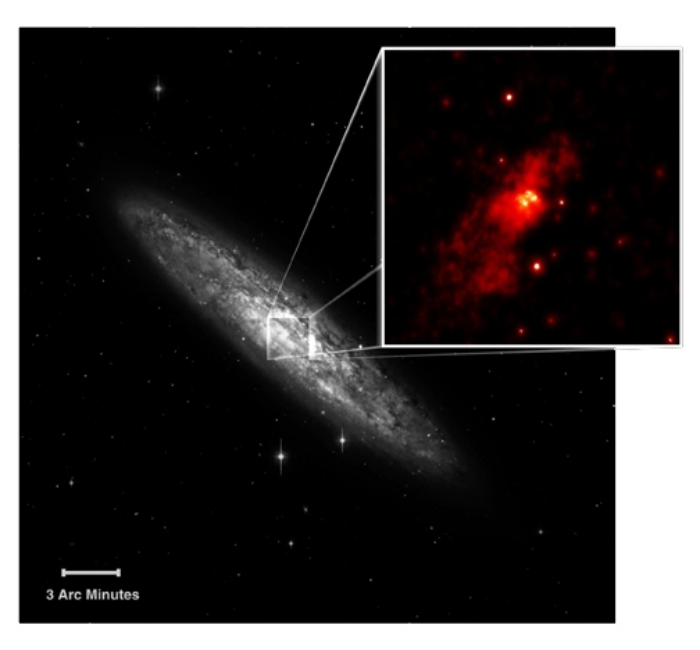
 Credit: X-ray: NASA/SAO/CXC, Optical: ESO
Credit: X-ray: NASA/SAO/CXC, Optical: ESO
Gathering of Black Holes?
Many if not most galaxies are thought to contain super massive black holes
in their centers. These supermassive black holes contain the equivalent
mass of millions of stars, and in extreme cases, they produce incredible
amounts of radiation by swallowing stars and gas in their neighborhood.
It's a mystery though how these supermassive black holes form - do they act
as the seed around which the rest of the galaxy forms, or does the galaxy
form first, and are the supermassive black holes built up gradually from
relatively small mass objects over a period of time? An observation
of the galaxy known as NGC 253 by the Chandra X-ray observatory may have
provided an important clue. NGC 253 is a "starburst" galaxy, in which large
numbers of massive stars form over a relatively brief period of time. The
image above shows an optical image of NGC 253, along with a zoomed X-ray
image of the core of NGC 253, shown in the inset in the upper right. The
sharpness of the new Chandra observation has enabled astronomers to locate
six so-called "superluminous X-ray sources" in NGC 253. These
superluminous sources are so bright in X-rays that they are very likely
"medium-mass" black holes, black holes with a mass of hundreds of solar
masses, visible as bright sources in the inset X-ray image.
Interestingly four of the six ultraluminous sources lie very near the core
of the galaxy, within only 3000 light years. Astronomers suspect that
these medium mass black holes are "falling" towards the center of the
galaxy, and if so they will eventually combine to form a single, more
massive black hole. Are these medium mass black holes the building blocks
out of which a supermassive black hole is made?
Last Week *
HEA Dictionary * Archive
* Search HEAPOW
* Education
Each week the HEASARC
brings you new, exciting and beautiful images from X-ray and Gamma ray
astronomy. Check back each week and be sure to check out the HEAPOW archive!
Page Author: Dr. Michael F.
Corcoran
Last modified July 16, 2001


